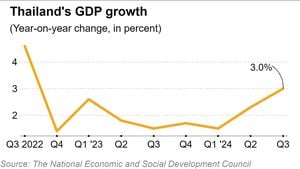The world of soccer is facing alarming news as reports indicate a significant increase in injuries during the 2025 season, raising concerns among players, coaches, and medical professionals alike. This uptick, particularly pronounced among players aged 30 and above, highlights the physical toll of the sport at higher levels.
Dr. Susan Bone, a sports medicine physician, recently remarked, "We are seeing levels of injury we haven’t witnessed before, especially among older players," highlighting how the intensity of competition can lead to such high rates of injury. The injuries reported range from muscle strains to ligament damage and concussions, underscoring the myriad hazards associated with professional soccer.
Coaches are also taking note of these troubling trends. Marco Silva, head coach of the Everton Football Club, commented, "The demands on players today are just more intense than ever, and we need to adapt our training and recovery methods accordingly.” This statement points to the growing need for teams to not only focus on the physical performance of their athletes but also on their health and well-being.
The 2025 soccer season has seen professional players experiencing unprecedented injury rates. Studies indicated injuries resulting from increased playing intensity, insufficient recovery times, and perhaps outdated training protocols. Statistics reveal a stark rise, with muscle strains becoming particularly common, alongside serious conditions such as ligament injuries.
Lisa Chen, a sports physiotherapist, expressed her concern, stating, "It’s alarming to see how common these injuries have become and the direct effects on players’ careers." The injuries impact not just the athletes’ immediate performance but can have lasting effects over their professional journeys. Athletes forced to endure the rigorous demands of the sport may find recovery more challenging than their predecessors.
Understanding the contributing factors to this increase is imperative for developing suitable strategies to combat it. Analysts suggest the cumulative effect of high-pressure training and match schedules as significant contributors. Many leagues have increased the number of games played each season, putting strain on players’ bodies.
Professional soccer, with its global reach and popularity, faces the serious challenge of ensuring player safety amid these intensifying conditions. Experts advocate for changes to training methods and player recovery protocols to offset the growing risk of injuries.
The problem extends beyond just statistics and reports; it cuts to the core of the sport, where the health of players becomes just as important as the pursuit of victory. Coaches must instill strategies focused on the holistic well-being of their athletes, ensuring they are not only game-ready but also able to sustain their careers.
There is also increasing pressure on leagues and governing bodies to reevaluate their regulations, particularly concerning how many games players are required to play within tight schedules. This evaluation might include extending rest periods or modifying training regimens to include more recovery time.
With the 2025 season still underway, sports officials, coaches, and players must seriously contemplate these issues. The future of the sport might depend on their ability to adapt and promote healthier practices.
While the challenge is significant, the measures taken now can lead to improved longevity for the athletes and enhanced safety protocols within the sport. The goal is clear: reducing the injury rate is not just about retaining superstar athletes but about taking care of human beings engaged in the beautiful game.
Efforts to mitigate injuries could see more input from sports medicine experts and physiotherapists, collaborating with teams to establish optimal training and recovery strategies. Greater emphasis on education around injury prevention is also being called for, particularly concerning the risks of play—especially for those entering their thirties, who face heightened susceptibility to injuries.
The dialogues initiated this season about player health symbolize not just concern for those the public cheer for, but for the integrity of the sport itself. Leading voices within the soccer community are beginning to recognize the need for structural changes, serving as a clarion call for reforms.
Only through concerted efforts can the sport create environments conducive to safe play, protecting those who have dedicated their lives to it. This time for reflection and proactive changes must not be overlooked, as the welfare of players intertwines intrinsically with the future of soccer.



